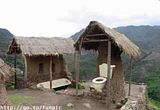In related thread:-
http://www.bushcraftuk.com/community/showthread.php?p=271585#post271585
an idea has evolved to lay down a slightly unusual challenge for anyone who wishes to have a go. I am pretty sure that this is possible in a number of ways, but I haven't yet had a go at any of them other than in my head. Anyone can be a "winner" if they achieve the aim. I am planning to make up some (simple) badges and certificates "Under water firelighter" for any successes. If you come up with a unique solution then you will get a slightly better badge and certificate.
The only valid reason for issuing this challenge is that if you can achieve this then you will have extended your fire lighting skills, so making it more likely you will succeed under less adverse condtions.
The Challenge: To light a fire by primitive means under water.
This needs a number of clarifications:-
Fire - this means a glowing coal, a momentary flame, or if you want to be really impressive then a sustained flame for one minute.
Primitive - This means friction (wood on wood), flint and steel, lens, or fire piston. Would be delighted to hear of successes by other means (chemical, compressed air pumps etc etc), They would get an "honourable mention" but it doesn't get the badge.
Under water:- This means either totally in water (could be tricky!), in a small air space under water (such as an upturned bowl, bucket or glass), or under a functioning waterfall with the water deflected by something (no assistance from someone else).
Evidence - a good description - with or without a photo or video - that is deemed likely to be achieved by someone else following your technique..
Oh, yes I suggest the referee's decision is final.
http://www.bushcraftuk.com/community/showthread.php?p=271585#post271585
an idea has evolved to lay down a slightly unusual challenge for anyone who wishes to have a go. I am pretty sure that this is possible in a number of ways, but I haven't yet had a go at any of them other than in my head. Anyone can be a "winner" if they achieve the aim. I am planning to make up some (simple) badges and certificates "Under water firelighter" for any successes. If you come up with a unique solution then you will get a slightly better badge and certificate.
The only valid reason for issuing this challenge is that if you can achieve this then you will have extended your fire lighting skills, so making it more likely you will succeed under less adverse condtions.
The Challenge: To light a fire by primitive means under water.
This needs a number of clarifications:-
Fire - this means a glowing coal, a momentary flame, or if you want to be really impressive then a sustained flame for one minute.
Primitive - This means friction (wood on wood), flint and steel, lens, or fire piston. Would be delighted to hear of successes by other means (chemical, compressed air pumps etc etc), They would get an "honourable mention" but it doesn't get the badge.
Under water:- This means either totally in water (could be tricky!), in a small air space under water (such as an upturned bowl, bucket or glass), or under a functioning waterfall with the water deflected by something (no assistance from someone else).
Evidence - a good description - with or without a photo or video - that is deemed likely to be achieved by someone else following your technique..
Oh, yes I suggest the referee's decision is final.





 OO OO I got it. Ok it is a bit nasty. Eat loads of chick pea curry. The next day sit in deep bath with bucket. Replace water in bucket with natural gas. Use fire steel to light gas. A cloth soaked in linseed oil might pyrolise in these conditions, but i think you would need alot of gas.
OO OO I got it. Ok it is a bit nasty. Eat loads of chick pea curry. The next day sit in deep bath with bucket. Replace water in bucket with natural gas. Use fire steel to light gas. A cloth soaked in linseed oil might pyrolise in these conditions, but i think you would need alot of gas. This is more likely to give you carbon monoxide poisoning, and a really unhealthy dose of cyclic hydrocarbons than make fire isn't it. Strange the things you realise when you sleep on it.
This is more likely to give you carbon monoxide poisoning, and a really unhealthy dose of cyclic hydrocarbons than make fire isn't it. Strange the things you realise when you sleep on it.